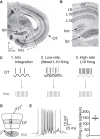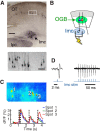Parallel midbrain microcircuits perform independent temporal transformations
- PMID: 24920618
- PMCID: PMC4051971
- DOI: 10.1523/JNEUROSCI.4399-13.2014
Parallel midbrain microcircuits perform independent temporal transformations
Abstract
The capacity to select the most important information and suppress distracting information is crucial for survival. The midbrain contains a network critical for the selection of the strongest stimulus for gaze and attention. In avians, the optic tectum (OT; called the superior colliculus in mammals) and the GABAergic nucleus isthmi pars magnocellularis (Imc) cooperate in the selection process. In the chicken, OT layer 10, located in intermediate layers, responds to afferent input with gamma periodicity (25-75 Hz), measured at the level of individual neurons and the local field potential. In contrast, Imc neurons, which receive excitatory input from layer 10 neurons, respond with tonic, unusually high discharge rates (>150 spikes/s). In this study, we reveal the source of this high-rate inhibitory activity: layer 10 neurons that project to the Imc possess specialized biophysical properties that enable them to transform afferent drive into high firing rates (~130 spikes/s), whereas neighboring layer 10 neurons, which project elsewhere, transform afferent drive into lower-frequency, periodic discharge patterns. Thus, the intermediate layers of the OT contain parallel, intercalated microcircuits that generate different temporal patterns of activity linked to the functions of their respective downstream targets.
Keywords: attention; colliculus; decision; inhibition; tectum.
Copyright © 2014 the authors 0270-6474/14/348130-09$15.00/0.
Figures






Similar articles
-
Morphology and connections of nucleus isthmi pars magnocellularis in chicks (Gallus gallus).J Comp Neurol. 2004 Feb 2;469(2):275-97. doi: 10.1002/cne.11007. J Comp Neurol. 2004. PMID: 14694539
-
Categorical Signaling of the Strongest Stimulus by an Inhibitory Midbrain Nucleus.J Neurosci. 2020 May 20;40(21):4172-4184. doi: 10.1523/JNEUROSCI.0042-20.2020. Epub 2020 Apr 16. J Neurosci. 2020. PMID: 32300047 Free PMC article.
-
A shared inhibitory circuit for both exogenous and endogenous control of stimulus selection.Nat Neurosci. 2013 Apr;16(4):473-8. doi: 10.1038/nn.3352. Epub 2013 Mar 10. Nat Neurosci. 2013. PMID: 23475112 Free PMC article.
-
Generating oscillatory bursts from a network of regular spiking neurons without inhibition.J Comput Neurosci. 2009 Dec;27(3):591-606. doi: 10.1007/s10827-009-0171-5. Epub 2009 Jul 2. J Comput Neurosci. 2009. PMID: 19572191 Free PMC article.
-
The role of a midbrain network in competitive stimulus selection.Curr Opin Neurobiol. 2011 Aug;21(4):653-60. doi: 10.1016/j.conb.2011.05.024. Epub 2011 Jun 21. Curr Opin Neurobiol. 2011. PMID: 21696945 Free PMC article. Review.
Cited by
-
A Midbrain Inspired Recurrent Neural Network Model for Robust Change Detection.J Neurosci. 2022 Nov 2;42(44):8262-8283. doi: 10.1523/JNEUROSCI.0164-22.2022. Epub 2022 Sep 19. J Neurosci. 2022. PMID: 36123120 Free PMC article.
-
Spatial Dependence of Stimulus Competition in the Avian Nucleus Isthmi Pars Magnocellularis.Brain Behav Evol. 2019;93(2-3):137-151. doi: 10.1159/000500192. Epub 2019 Aug 15. Brain Behav Evol. 2019. PMID: 31416080 Free PMC article.
-
Spatially precise visual gain control mediated by a cholinergic circuit in the midbrain attention network.Nat Commun. 2016 Nov 17;7:13472. doi: 10.1038/ncomms13472. Nat Commun. 2016. PMID: 27853140 Free PMC article.
-
Space-Specific Deficits in Visual Orientation Discrimination Caused by Lesions in the Midbrain Stimulus Selection Network.Curr Biol. 2017 Jul 24;27(14):2053-2064.e5. doi: 10.1016/j.cub.2017.06.011. Epub 2017 Jun 29. Curr Biol. 2017. PMID: 28669762 Free PMC article.
-
Directional Preference in Avian Midbrain Saliency Computing Nucleus Reflects a Well-Designed Receptive Field Structure.Animals (Basel). 2022 Apr 28;12(9):1143. doi: 10.3390/ani12091143. Animals (Basel). 2022. PMID: 35565569 Free PMC article.
References
-
- Dutar P, Vu HM, Perkel DJ. Multiple cell types distinguished by physiological, pharmacological, and anatomic properties in nucleus HVc of the adult zebra finch. J Neurophysiol. 1998;80:1828–1838. - PubMed
Publication types
MeSH terms
Substances
Grants and funding
LinkOut - more resources
Full Text Sources
Other Literature Sources
Miscellaneous
